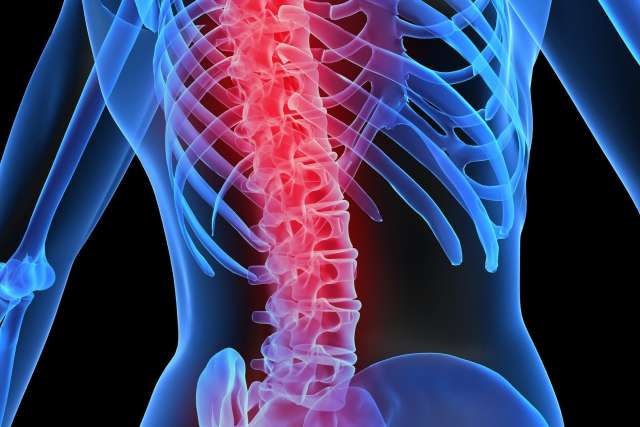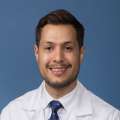After years of suffering from debilitating back pain, a patient may undergo spinal surgery followed by weeks of recovery and rehabilitation — only for the pain to endure. This common, maddening puzzle is something that neurosurgeon Andrew Vivas, MD, is trying to understand.
Dr. Vivas, an assistant clinical professor in the Department of Neurosurgery and Orthopedic Surgery at the David Geffen School of Medicine, began his career studying and treating epilepsy. After receiving surgery to treat epileptic seizures, some patients experience something called secondary epileptogenesis or “kindling,” Dr. Vivas says. It happens when seizure activity develops in a new, secondary part of the brain.
“The seizures start in a specific location [of the brain], which we call the seizure focus. But if you leave someone untreated, they will develop a secondary focus,” Dr. Vivas says.
He thinks patients with chronic back pain could be experiencing a similar phenomenon.
“Because they’ve been in pain for so long, they have these changes that occur in the sensory or pain processing portions of the brain,” he says. “Even after you fix the structural problem, those changes remain.”
Dr. Vivas is among a group of neurosurgeons who make up the UCLA Health Spine Center. Funded by the National Institutes of Health, the clinicians have diverse research portfolios that are changing the paradigm of spine care.
Targeted treatments, better outcomes for chronic pain
Dr. Vivas’ goal is to uncover why so many people continue to experience pain post-spine surgery. By using advanced functional imaging studies, he’s figuring out how network connectivity changes in the brain contribute to chronic pain — and he’s investigating new, functional ways to treat those abnormalities, like brain stimulation or even medication.
Secondarily, Dr. Vivas is investigating the molecular mechanism by which degenerative processes occur in the spine. With degenerative conditions such as spinal stenosis, the spinal canal narrows, pinching nerves and leading to inflammation and weakness. The condition is caused by the thickening of ligaments or overgrowth of bones in the area — though no one fully understands why.
“We know there is a genetic mechanism by which that happens, we just don’t really understand what it is,” Dr. Vivas says.
If researchers can better understand the genetic underpinnings of spinal stenosis and other degenerative disease, there could be potential to prevent — or even reverse — those changes without needing to intervene surgically, Dr. Vivas says. A treatment like immunotherapy, for example, could be used to slow the degenerative process.
“I think, ultimately one day, the things we’re doing in spine surgery are going to be regarded as barbaric,” Dr. Vivas says.
In the meantime, neurosurgeons at UCLA Health are already using cutting-edge technologies and minimally invasive treatments to make spine surgery safer, more efficient, and with better outcomes.
With tools like spinal image guidance, surgeons no longer need to make large incisions, which means shorter, easier recoveries, according to Langston Holly, MD, professor, co-director of the UCLA Health Spine Center, and executive vice chair of the Department of Neurosurgery at the David Geffen School of Medicine.
“It’s essentially like having a GPS system to direct you to the optimal path to your destination,” Dr. Holly says. “The imaging allows us to understand the underlying spinal anatomy, even when we haven’t made any incisions. It’s safer, and, at the same time, it’s much more accurate.”
After spinal cord injury, restoring functionality
While chronic back pain develops slowly over time and typically affects patients at an older age,
spinal cord injuries (SCI) can change a patient’s life in an instant, usually when they’re in their physical prime.
When Daniel Lu, MD, PhD, professor and vice chair of research for the Department of Neurosurgery, started treating SCI patients over a decade ago, he was frustrated by how little he could help them return to some semblance of normal life. The goal of surgery, he says, was simply to stabilize the patient, not to help them regain function.
“The options we had when I started this venture were highly, highly inadequate. That’s the driving force behind what I do — after all of my training and a decade-plus of doing surgery, the treatment would have zero impact on whether a patient can regain strength or not? To me, that’s unsatisfying and unacceptable,” says Dr. Lu, who is principal investigator of the Neuroplasticity & Repair Laboratory at UCLA Health. “That’s why I started my laboratory and started a program at UCLA to restore function to patients.”
In 2014, a team led by Dr. Lu showed that electrical stimulation of the spinal cord could restore lower extremity function and ambulation in patients with spinal cord injury. In a 2016 study, Dr. Lu and his team showed that electrical epidural stimulation could restore hand strength and control in patients with quadriplegia. And in 2018, Lu’s group showed that stimulation of the lower spine helped five patients recover significant bladder control.
This year, Dr. Lu and team demonstrated the effects of spinal stimulation on restoring breathing function and elucidated the mechanism of such novel respiratory circuit. Over the past decade, he has obtained over $20 million in funding from the National Institutes of Health and the Department of Defense in support of his research.
The remote neurologic exam
In his clinical practice, Joel Beckett, MD, sees patients for 15-minute appointments. He treats symptoms of herniated discs, spinal cord injuries, spinal stenosis, and other diagnoses, but he’s most interested in what’s going on with patients outside of the office.
“What I really want to know about a patient, I’m not going to be able to capture it in that appointment,” says Dr. Beckett, a Health Sciences assistant clinical professor in the Department of Neurosurgery. “What I want to see is you walking out and about.”
To simulate everyday movement with more accuracy, every patient who comes through Dr. Beckett’s clinic has their walk and dexterity recorded. Then, artificial intelligence is used to measure things like gait and slight deviations in movement, which is compared to their movement during a follow-up appointment. This helps track a patient’s progress and guide clinical decisions.
“There is, for example, a common disease process called cervical myelopathy. The most aggressive mentality is that even if you have a bit of spinal compression, some surgeons will recommend you have surgery right away. We don’t often know what the future holds for very mild cervical myelopathy,” Dr. Beckett says. “Instead, let’s monitor it.”
The long-term goal will be to develop and arm patients with a HIPAA-protected smartphone app that will use artificial intelligence to track small changes in bodily movements. The app will allow a patient (or a caregiver) to video record their own gait and other movements from the privacy and comfort of their own home. The data will then be sent directly to Dr. Beckett who can measure and assess the patient’s progress — a so-called “remote neurologic exam.”
The patient will no longer have to come into the clinic for regular appointments, and Dr. Beckett and his team will be able to collect population-level data on the progression of different diagnoses.
“We’ll be able to figure out, say, what the gait of someone with a herniated disk really looks like over time,” Dr. Beckett says. “The textbooks talk about it in a high-brow, academic sense, but we don’t have population-wide, high-quality data.”
Dr. Beckett says that the strength of UCLA’s entire spine surgery program is having a diverse, research-oriented group of clinicians who know not only when to recommend surgery – but also when they can prevent it.
“When you come to UCLA neurosurgery, you’re truly getting the group opinion that has your best interest in mind,” he says.
Lauren Ingeno is the author of this article.





